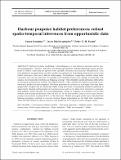Files in this item
Harbour porpoise habitat preferences : robust spatio-temporal inferences from opportunistic data
Item metadata
| dc.contributor.author | Isojunno, Saana | |
| dc.contributor.author | Matthiopoulos, Jason | |
| dc.contributor.author | Evans, Peter G H | |
| dc.date.accessioned | 2018-10-12T15:30:09Z | |
| dc.date.available | 2018-10-12T15:30:09Z | |
| dc.date.issued | 2012-02-23 | |
| dc.identifier | 251763465 | |
| dc.identifier | bb617f9e-789c-41ab-9f1f-1734281e8782 | |
| dc.identifier.citation | Isojunno , S , Matthiopoulos , J & Evans , P G H 2012 , ' Harbour porpoise habitat preferences : robust spatio-temporal inferences from opportunistic data ' , Marine Ecology Progress Series , vol. 448 , pp. 155-170 . https://doi.org/10.3354/meps09415 | en |
| dc.identifier.issn | 0171-8630 | |
| dc.identifier.other | Bibtex: urn:6d164c4e758084cf525aef94b857071e | |
| dc.identifier.other | ORCID: /0000-0002-2212-2135/work/39714953 | |
| dc.identifier.uri | https://hdl.handle.net/10023/16207 | |
| dc.description.abstract | Statistical habitat modelling is often flagged as a cost-effective decision tool for species management. However, data that can produce predictions with the desired precision are difficult to collect, especially for species with spatially extensive and dynamic distributions. Data from platforms of opportunity could be used to complement or help design dedicated surveys, but robust inference from such data is challenging. Furthermore, regression models using static covariates may not be sufficient for animals whose habitat preferences change dynamically with season, environmental conditions or foraging strategy. More flexible models introduce difficulties in selecting parsimonious models. We implemented a robust model-averaging framework to dynamically predict harbour porpoise Phocoena phocoena occurrence in a strongly tidal and topographically complex site in southwest Wales using data from a temporally intensive platform of opportunity. Spatial and temporal environmental variables were allowed to interact in a generalized additive model (GAM). We used information criteria to examine an extensive set of 3003 models and average predictions from the best 33. In the best model, 3 main effects and 2 tensorproduct interactions explained 46% of the deviance. Model-averaged predictions indicated that harbour porpoises avoided or selected steeper slopes depending on the tidal flow conditions; when the tide started to ebb, occurrence was predicted to increase 3-fold at steeper slopes. | |
| dc.format.extent | 16 | |
| dc.format.extent | 4393533 | |
| dc.language.iso | eng | |
| dc.relation.ispartof | Marine Ecology Progress Series | en |
| dc.subject | Generalized additive models | en |
| dc.subject | Habitat model | en |
| dc.subject | Wales | en |
| dc.subject | Model selection | en |
| dc.subject | Tidal environments | en |
| dc.subject | Phocoena phocoena | en |
| dc.subject | Non-linear interactions | en |
| dc.subject | Multi-model inference | en |
| dc.subject | GC Oceanography | en |
| dc.subject | HA Statistics | en |
| dc.subject.lcc | GC | en |
| dc.subject.lcc | HA | en |
| dc.title | Harbour porpoise habitat preferences : robust spatio-temporal inferences from opportunistic data | en |
| dc.type | Journal article | en |
| dc.contributor.institution | University of St Andrews. School of Biology | en |
| dc.contributor.institution | University of St Andrews. Marine Alliance for Science & Technology Scotland | en |
| dc.contributor.institution | University of St Andrews. Scottish Oceans Institute | en |
| dc.contributor.institution | University of St Andrews. Centre for Research into Ecological & Environmental Modelling | en |
| dc.identifier.doi | https://doi.org/10.3354/meps09415 | |
| dc.description.status | Peer reviewed | en |
This item appears in the following Collection(s)
Items in the St Andrews Research Repository are protected by copyright, with all rights reserved, unless otherwise indicated.

